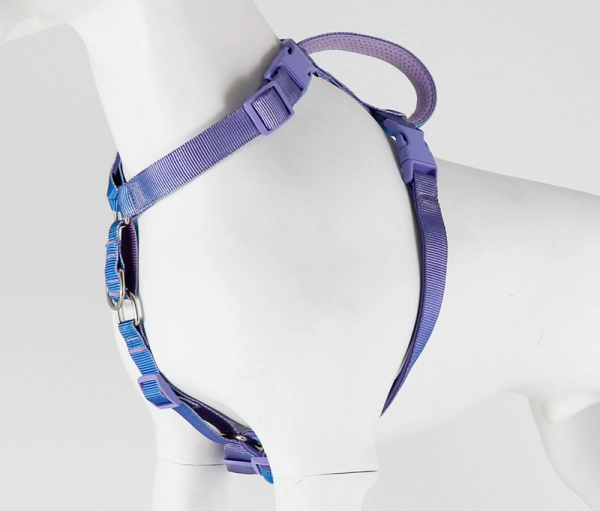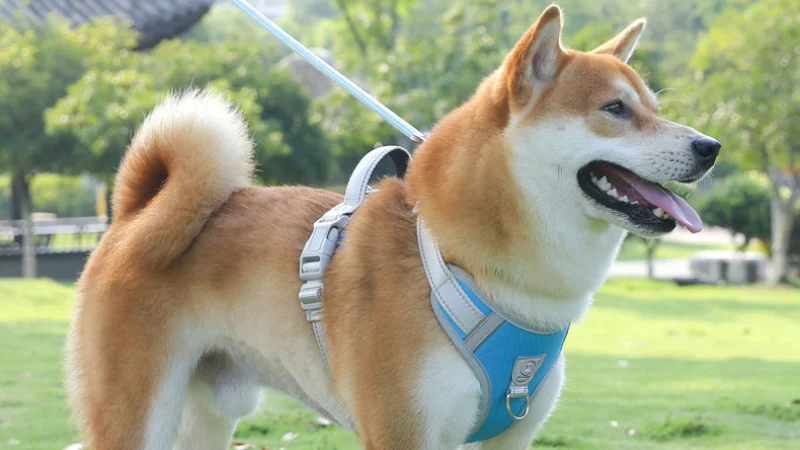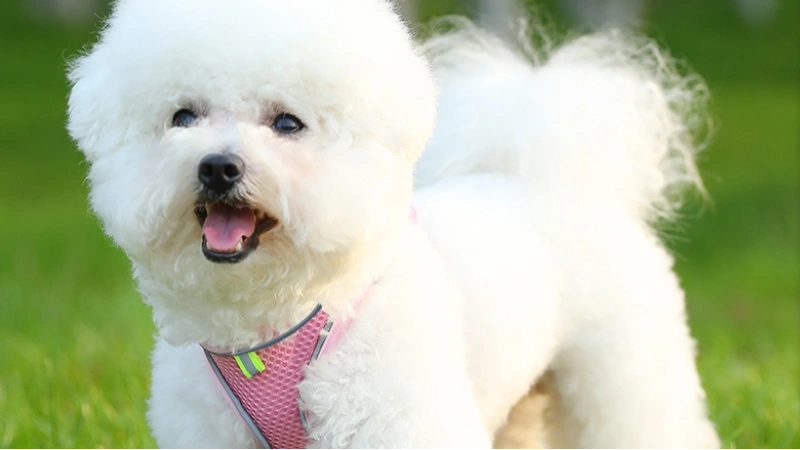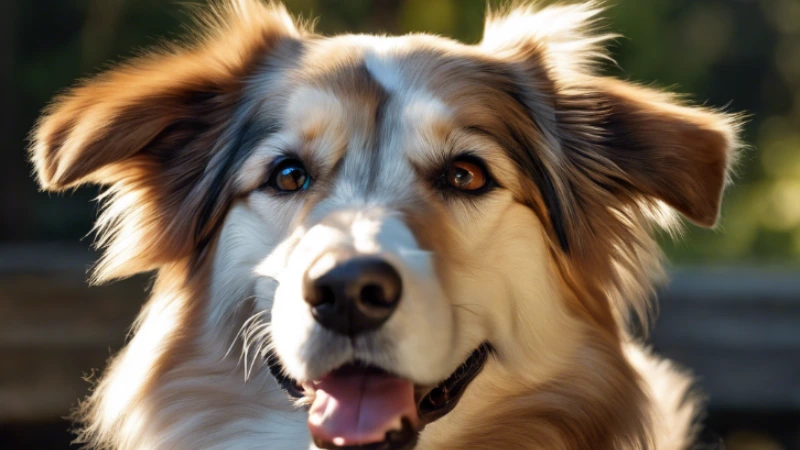This comprehensive guide will walk you through everything you need to know about Y-shaped dog harnesses. Whether you’re a first-time dog owner or a seasoned pet parent, we’ve got you covered with practical advice and solutions to common harness-related problems.
What is a Y-shaped dog harness?

A Y-shaped dog harness is a type of harness that forms a “Y” shape across the dog’s chest and shoulders. It features a strap that goes around the neck and another strap that branches out in the middle down to the chest, running to the sides behind the front legs and meeting at a point on the dog’s back. This design offers several benefits, including improved comfort, freedom of movement, and better pressure distribution across the dog’s body It’s designed with your pup’s comfort and freedom of movement in mind.
Are Y-shaped harnesses bad for dogs?
You might have heard some concerns about harnesses being bad for dogs. Let’s clear that up right away: when used correctly, Y-shaped harnesses are not bad for dogs. In fact, they can be a safer and good comfortable alternative to traditional collars, especially for certain types of dogs.
Here’s the scoop:
- For dogs prone to respiratory issues (like pugs or bulldogs), a Y-shaped harness can be a lifesaver. It takes pressure off the throat, making breathing easier during walks.
- If your dog tends to pull during walks, a Y-shaped harness can help distribute the force more evenly, reducing the risk of neck injuries.
However, it’s crucial to remember that any harness – even a Y-shaped one – can potentially cause problems if it’s not used correctly. Here are some key points to keep in mind:
- Proper fit is essential: A poorly fitting harness can cause chafing, restrict movement, or even allow your dog to escape.
- Regular checks are important: Always check the fit of the harness before each use, especially for growing puppies or dogs that have gained or lost weight.
- Watch for signs of discomfort: If your dog seems uncomfortable or their gait changes when wearing the harness, it might not be the right fit or style for them.
What’s the difference between Y-front and other dog harnesses?
Now that you understand what a Y-shaped harness is, you might be wondering how it stacks up against other types of harnesses. Let’s break it down:
Y-shaped harnesses:
- Pros: Comfortable, allows natural movement, distributes pressure evenly
- Cons: May not provide as much control for very strong pullers
H-harnesses:
- Pros: Provides more control, good for larger breeds or strong pullers
- Cons: Can be more restrictive, may not be as comfortable for all-day wear
Step-in harnesses:
- Pros: Easy to put on, good for small dogs
- Cons: May not provide as much control, can be easier for dogs to slip out of
Front-clip harnesses:
- Pros: Great for discouraging pulling, provides good control
- Cons: Can restrict shoulder movement, may cause chafing in some dogs
When choosing between these types, consider your dog’s size, behavior, and specific needs. For many dogs, a Y-shaped harness offers the best balance of comfort and control.
How should a Y-harness fit? A step-by-step guide
Getting the right fit is crucial for your dog’s comfort and safety. Here’s a simple guide to ensure your Y-harness fits perfectly(You Can also check (how to wear different types of harnesses):
Step 1: Measure your dog
- Wrap a soft tape measure around the widest part of your dog’s chest, usually right behind the front legs.
- Make sure you can fit two fingers between the tape and your dog’s body.
- Write down this measurement – it’s your dog’s chest girth.
Step 2: Choose the right size
- Use the manufacturer’s size chart to select the appropriate harness size based on your dog’s chest girth.
- If your dog falls between sizes, it’s usually best to go with the larger size.
Step 3: Put on the harness
- Place the harness over your dog’s head.
- Bring the chest strap down between the front legs.
- Fasten the buckles on both sides behind the front legs.
Step 4: Adjust for a perfect fit
- The harness should be snug but not tight. You should be able to fit two fingers between the harness and your dog’s body at any point.
- The front panel shouldn’t stretch across the shoulders – if it does, the harness is too small.
- Ensure there’s no pressure on the throat area.
- Check that all straps are evenly adjusted on both sides.
Step 5: Test the fit
- Have your dog walk around in the harness.
- Watch for any signs of discomfort or restricted movement.
- Make sure your dog can’t back out of the harness when slight pressure is applied to the leash.
Is H or Y-harness better?
When it comes to choosing between an H-harness and a Y-harness, there’s no one-size-fits-all answer. The best choice depends on your dog’s specific needs and your walking habits. Let’s break it down to help you make the right decision:
Y-harness: best for
- Dogs with sensitive necks or respiratory issues
- Breeds prone to tracheal collapse (like Chihuahuas or Yorkshire Terriers)
- Dogs that need gentle leash training
- Everyday walks and general use
H-harness: best for
- Larger breeds or muscular dogs
- Strong pullers who need more control
- Active dogs who participate in sports or agility training
- Situations where maximum security is needed (like in crowded areas)
Why choose a Y-harness?
Now that we’ve compared different harness types, let’s dive deeper into why a Y-harness might be the perfect choice for your dog. Here are some compelling reasons:
- Y-harnesses are a popular choice for several reasons:
- Ergonomic design that supports natural movement and growth
- Even pressure distribution across the chest and shoulders, reducing the risk of injury
- Improved control without causing discomfort, making walks more enjoyable
- Adjustable straps for a perfect fit, ensuring comfort during extended wear
- Suitable for dogs of all sizes and breeds
Is a Y-shaped harness right for your dog?
After exploring all the benefits and considerations, you might be wondering if a Y-shaped harness is the right choice for your furry companion. Here’s a simple checklist to help you decide:
✓ Your dog has a sensitive neck or respiratory issues
✓ You want to reduce the risk of neck injuries during walks
✓ Your dog needs gentle leash training
✓ You’re looking for a comfortable, everyday walking solution
✓ Your dog’s comfort during extended wear is a priority
✓ You want a harness that can grow with your dog
If you checked most of these boxes, a Y-shaped harness could be an excellent choice for your dog. However, it’s essential to remember that every dog is unique. What works for one might not work for another.
Final tips for success with your Y-harness
- Introduce the harness gradually: Let your dog sniff and investigate the harness before putting it on. Use treats and praise to create positive associations.
- Start with short wearing sessions: Begin with just a few minutes at a time and gradually increase the duration as your dog gets comfortable.
- Monitor for any signs of discomfort: Watch for chafing, hair loss, or changes in your dog’s gait. If you notice any issues, adjust the fit or consult with a professional.
- Regular maintenance: Clean the harness according to the manufacturer’s instructions and check for any wear and tear regularly.
- Combine with positive reinforcement training: Use the harness as part of a positive training routine to encourage good walking behavior.
Conclusion
Y-shaped harnesses can be an excellent choice for many dogs, offering a comfortable and secure alternative to traditional collars. However, it’s essential to consider your dog’s specific needs, behavior, and body type when selecting a harness. Always ensure proper fit and adjustment to maximize the benefits and prevent any potential issues. If you have concerns or questions, consult with a professional trainer or veterinarian for guidance.
By the way, Wedogy is a Chinese factory with 10 years of experience making dog harnesses. Whether you’re a pet store owner, distributor, or just looking to buy in bulk, we’ve got you covered. Reach out to Wedogy today and discover our range of premium Y-shaped harnesses and other pet accessories. Our team is standing by to answer your questions and help you find the ideal solution for your needs.





